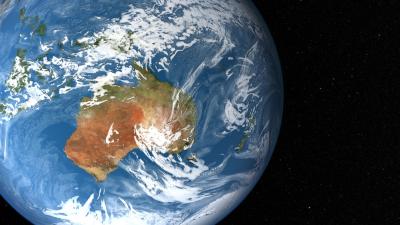Ocean winds keep Antarctica cold, Australia dry

Clouds over Australia are shown. Credit: NASA Goddard Space Flight Centre Scientific Visualization Studio.
New Australian National University-led research has explained why Antarctica is not warming as much as other continents, and why southern Australia is recording more droughts.
Researchers have found rising levels of carbon dioxide in the atmosphere are strengthening the stormy Southern Ocean winds which deliver rain to southern Australia, but pushing them further south towards Antarctica.
Lead researcher Nerilie Abram, from the ANU Research School of Earth Sciences, said the findings explained the mystery over why Antarctica was not warming as much as the Arctic, and why Australia faces more droughts.
“With greenhouse warming, Antarctica is actually stealing more of Australia's rainfall. It's not good news – as greenhouse gases continue to rise we'll get fewer storms chased up into Australia,” Dr Abram said.
“As the westerly winds are getting tighter they're actually trapping more of the cold air over Antarctica,” Abram said. “This is why Antarctica has bucked the trend. Every other continent is warming, and the Arctic is warming fastest of anywhere on earth.”
While most of Antarctica is remaining cold, rapid increases in summer ice melt, glacier retreat and ice shelf collapses are being observed in Antarctic Peninsula, where the stronger winds passing through Drake Passage are making the climate warm exceptionally quickly.
Until this study, published in Nature Climate Change, Antarctic climate observations were available only from the middle of last century.
By analysing ice cores from Antarctica, along with data from tree rings and lakes in South America, Dr Abram and her colleagues were able to extend the history of the westerly winds back over the last millennium.
“The Southern Ocean winds are now stronger than at any other time in the past 1,000 years,” Abram said.
“The strengthening of these winds has been particularly prominent over the past 70 years, and by combining our observations with climate models we can clearly link this to rising greenhouse gas levels.”
Study co-authors Dr Robert Mulvaney and Professor Matthew England said the study answered key questions about climate change in Antarctica.
“Strengthening of these westerly winds helps us to explain why large parts of the Antarctic continent are not yet showing evidence of climate warming,” said Dr Mulvaney, from the British Antarctic Survey.
“This new research suggests that climate models do a good job of capturing how the westerly winds respond to increasing greenhouse gases,” added Professor England, from the Climate Change Research Centre at UNSW.
“This isn't good news for farmers reliant on winter rainfall over the southern part of Australia.”
Media Contact
All latest news from the category: Earth Sciences
Earth Sciences (also referred to as Geosciences), which deals with basic issues surrounding our planet, plays a vital role in the area of energy and raw materials supply.
Earth Sciences comprises subjects such as geology, geography, geological informatics, paleontology, mineralogy, petrography, crystallography, geophysics, geodesy, glaciology, cartography, photogrammetry, meteorology and seismology, early-warning systems, earthquake research and polar research.
Newest articles

A universal framework for spatial biology
SpatialData is a freely accessible tool to unify and integrate data from different omics technologies accounting for spatial information, which can provide holistic insights into health and disease. Biological processes…

How complex biological processes arise
A $20 million grant from the U.S. National Science Foundation (NSF) will support the establishment and operation of the National Synthesis Center for Emergence in the Molecular and Cellular Sciences (NCEMS) at…

Airborne single-photon lidar system achieves high-resolution 3D imaging
Compact, low-power system opens doors for photon-efficient drone and satellite-based environmental monitoring and mapping. Researchers have developed a compact and lightweight single-photon airborne lidar system that can acquire high-resolution 3D…





















